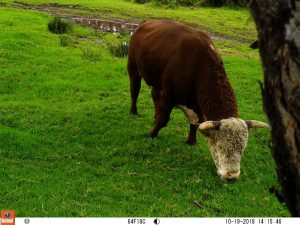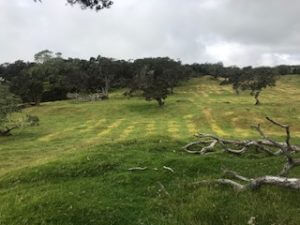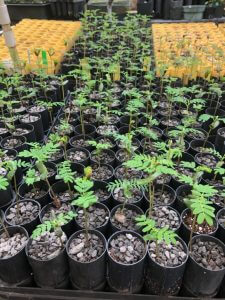Connecting Local Groups to National Funding for Groundwater Replenishment
“Ohia trees, which are considered the mother of all native forests [on Hawaii]…are under threat right now,” begins Cheyenne Hiapo Perry, Project Coordinator at the Mauna Kea Watershed Alliance (MKWA), an organization that’s been hard at work since 2009 preserving and rehabilitating the Big Island’s native forests, “…and if we did nothing, over 100 years the upper part of Mauna Kea, thousands of acres would probably be lost.”
The Mauna Kea rehabilitation site sits at the headwaters of the Wailuku River, which has the greatest volume of water moving through it in all of Hawaii and contributes around 365 million gallons of water per day to the watershed. The area is home to a large number of native animal and plant species, including two endemic canopy trees vital to the health of the areas forests: Ohia, which means “to gather” in Hawaiian and is uniquely adapted to thrive after lava flows, and Koa, which means “bold” or “fearless” in Hawaiian and is particularly fast-growing. However, due to decades of cattle ranching, growing feral ungulate populations, and development in the area, the health of the forests and watershed has steadily declined, leaving the area vulnerable to invasive species and fungal infection.

One of the area’s feral cows.
The most devastating threat to this area has come in the form of non-native feral cattle whose grazing habits have left Ohia trees vulnerable to a fungus known as Rapid Ohia Death, which can kill an infected tree in as few as two weeks. “You can’t tell that the tree is sick until it’s sick, and then two weeks later the tree has passed on,” explains Perry. This fungal infection, which began spreading more rapidly among the island’s Ohia trees after Hurricane Iselle hit in August 2014, spreads from tree to tree as feral cattle rub up against the tree trunks, leaving open wounds in the bark where the fungus can enter. And, because the infection is also windborne, it has impacted not just the island of Hawaii, but neighboring Oahu and Kauai islands as well. As a result, Mauna Kea is considered a hot spot in need of conservation, and containment and rehabilitation efforts are in full effect.
Together with the Hawaii Association of Watershed Partnerships (HAWP), which is a River Network member group, MKWA proposed the Waipahoehoe Groundwater Replenishment Project through the Business for Water Stewardship Project Bank, working with teams at Bonneville Environmental Foundation (BEF) and River Network to secure funding for their rehabilitation efforts. And because submitting projects to the BWS Project Bank is simple, with hands-on team support and access to a pool of potential sponsors, it gives even the most grassroots restoration projects, like MKWA’s, a chance to be funded — which means more communities are getting the support they need to care for their local waterways and ecosystems. Additionally, MKWA uses a grassroots-model of project management, meaning they’re able to ensure that a majority of the funding goes straight into the project itself.

Site prep for the open areas where native trees will be planted.
The Waipahoehoe Groundwater Replenishment Project focused largely on removing feral cattle from an 1,100-acre area of land on the north side of the island, slowing the spread of Rapid Ohia Death, and finally restoring the native forests by planting native Koa trees. Having effectively controlled the populations of feral cattle with the help of passive techniques such as fencing, cattle driving, and one-way gates, the restoration efforts in the area could finally begin. And this is where the benefits of partnering with River Network really came into play.
Because MKWA is a small grassroots organization, in order to access the sort of funding they needed to carry out the restoration efforts for 1,100 acres of land, they worked closely with HAWP and River Network to submit the project to the Project Bank. Then, BEF was able to take over, finding the perfect corporate sponsor, who was open to supporting the unique funding needs of the Waipahoehoe Groundwater Replenishment Project, and making the match.
“It can really be a chicken or egg situation,” explains Sara Hoversten, Director of Strategic Partnerships at BEF, “sometimes we have the sponsor first, and sometimes the project.” Typically these funding relationships start at the sponsor level, with sponsors articulating exactly the kind of project they’re looking to support, the geographic area they’re interested in working in, and even the anticipated restoration benefits. This level of specificity can sometimes lead to lengthy project/sponsor matchmaking. But luckily, in the case of the Waipahoehoe Groundwater Replenishment Project, it worked in just the opposite way.
Hovertsen knew about MKWA’s project—thanks to River Network’s collaboration in the BWS Project Bank—she was able to help connect them to the perfect sponsor. The sponsor, who had come to Hoversten with particularly flexible, unrestricted funding requirements, knew that they wanted to support a water project on Hawaii, but was open to whichever project the island needed support for most. Hovertsen presented the sponsor with the Waipahoehoe Groundwater Replenishment Project and it was a perfect match.
“It’s a dream situation when we are able to pitch a project from the Project Bank to a sponsor and they choose to fund it!” says Hovertsen. “It’s definitely a rare occasion when it works that way, [but] both the sponsor and project partner were happy, and that is what we care most about.”
“The River Network [partnership has been] really critical because all of those funds, I think nine thousand, went to buy plants. Because we’re at the part of our work where we’re almost finished removing the animals, we’re going into the restoration. So, we’re starting to grow those plants. The timing is perfect,” explains Perry.

Acacia koa seedlings growing in MKWA’s greenhouse.
As a result of this funding partnership, MKWA has been able to purchase over 6,000 Koa trees for rehabilitative planting, bringing their total number of trees to around 10,500. Though native forests are typically a mixture of Koa and Ohia trees, Koa grow substantially faster than Ohia and are not susceptible to Rapid Ohia Death fungus, making them a more sustainable option for restoration efforts in the area.
When it comes to measuring this project’s success, to Perry it all comes down to one thing: “As someone who does restoration, [success] is when the forest is healthy and it’s regenerating on its own. When the cycle has been changed from one where the forest is disappearing to where it’s actually self-propagating.” And within the next few years, once the Koa trees have been planted and are beginning to reinstate the area’s canopy, this success will be realized.
River Network’s partnership with the Project Bank has now ended.





